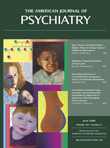Aripiprazole-Induced Acute Dystonia
To the Editor: Aripiprazole, the new-generation atypical antipsychotic that is a dopamine system stabilizer, is known for its low propensity to cause extrapyramidal symptoms (1) . Although several reports of dystonia associated with the use of newer atypical antipsychotics are accumulating, a thorough PubMed search through Nov. 6, 2005, did not reveal a single such case induced by aripiprazole. We report a case of acute dystonia observed during aripiprazole therapy.
“Mr. A,” an 18-year-old man with no contributory family, past, or personal history was brought to our community clinic with a 4-week history suggestive of a psychotic manic episode. Treatment was initiated with tablet divalproex, which was increased to 500 mg b.i.d., along with aripiprazole, 15 mg/day. In the next follow up, his parents complained about episodes suggestive of dystonia in the form of torticollis, which started within 3 days of treatment initiation. Mr. A did not receive any other medication in between. Trihexyphenidyl, 2 mg/day, was added to the regimen, and dystonia did not recur.
Exact mechanism of neuroleptic-induced acute dystonia is still unclear and possibly attributable to a higher ratio of dopamine-acetylcholine antagonism (2) or postsynaptic dopamine hypersensitivity (3) in the basal ganglia. However, preclinical studies with aripiprazole have shown that the drug’s unique partial agonism at dopamine D 2 and serotonin 5-HT 1A receptors, along with antagonism of 5-HT 2A receptors, actually protects against emergence of extrapyramidal symptoms (1) .
In our case report, Mr. A had two known risk factors for dystonia, i.e., being young and male (1) . Additionally, we propose the following neurobiological mechanisms that either alone or in combinations could have resulted in acute dystonia with aripiprazole.
First, aripiprazole—unlike clozapine, which does not induce acute dystonia—lacks protective anticholinergic action (1) . This was supported by the fact that, in our case, dystonia resolved with anticholinergic medicines. Second, aripiprazole’s action on the D 3 receptor and antagonism of 5-HT 6 and 5-HT 7 receptors is still unknown (1) and could play a potential role. Third, postsynaptic dopamine hypersensitivity was found in bipolar patients (4) , which may be a significant factor. Fourth, the possibility of complex drug interaction of aripiprazole with divalproex cannot be eliminated. Last, preclinical studies found inhibitory action of aripiprazole on serotonin transporter (1) , which could potentially alter dopamine balance in the basal ganglia region.
In short, our case report reveals that even aripiprazole may cause rare dystonia in vulnerable individuals, despite having a favorable receptor profile. However, this side effect is amenable to conventional anticholinergic treatment.
1. Keck PE, McElroy SL: Aripiprazole: a partial dopamine D 2 receptor agonist antipsychotic (expert opinion). Investig Drugs 2003; 12:655–662 Google Scholar
2. van Harten PN: Acute dystonia induced by drug treatment. BMJ 1999; 319:623–626Google Scholar
3. Marsden CD, Jenner P: The pathophysiology of extra-pyramidal side-effects of neuroleptic drugs. Psychol Med 1980; 10:55–72Google Scholar
4. Anand A, Verhoeff P, Seneca N, Zoghbi SS, Seibyl JP, Charney DS, Robert B, Innis RB: Brain SPECT imaging of amphetamine-induced dopamine release in euthymic bipolar disorder patients. Am J Psychiatry 2000; 157:1108–1114Google Scholar



